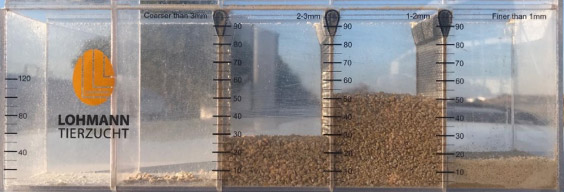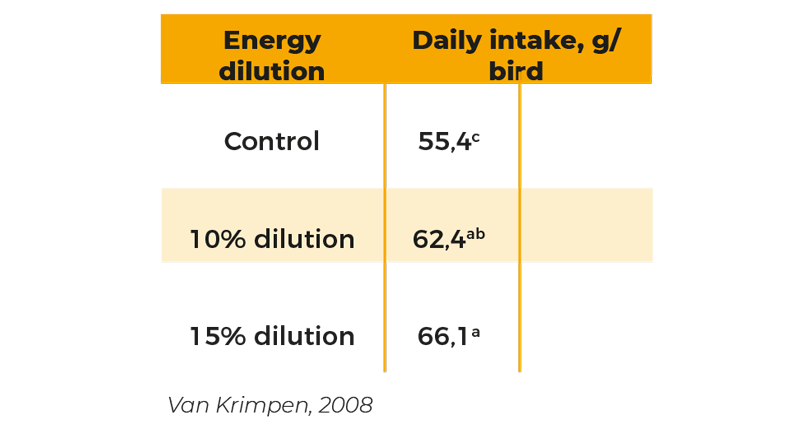Cage free production is fast becoming commonplace as a management system for our hens, these systems bring with them their own challenges and with this in mind a new approach to management practices and nutrition needs to be adopted to help us continue to achieve the excellent genetic potential we see in our cage systems.
Additional influences within these systems such as accessibility and movement behaviour can all have a bearing in the efficacy of feed intakes which can have the potential to have a negative impact on profitability and recovery periods of our flocks in the face of challenges.
Rearing phase
Whichever system you have, we can agree this is the most important period of a hen’s life, and in cage free systems the influence is even more pronounced.
Assuming that target body weights are the same for both systems we have to consider the additional requirements in relation to activity within the cage free system will naturally increase the nutrient needs of the hen.
An adequate combination of a higher nutrient density, with a preponderant role of amino-acid profile, a higher feed intake and an adequate feeding pattern will have a large influence on flock performance.
From a nutritional perspective we can simplify the rearing phase in cage free systems into two main target areas.
The body weight development profile & Imprinting of foraging behaviour. (Allowing the replication of natural behaviour in relation to food search/directional foraging and comfort behaviour within the litter area).


As a starting point from a management perspective, it’s important to provide early access to a good quality litter substrate. This not only redirects natural foraging behaviour to a safe area but also allows the pullets to express comfort behaviour of food search and dust bathing.
It can also help reduce misdirected feather pecking behaviour later in production (Blokhuis and Van de Haar,1989).
90% of birds showing pecking behaviour in rearing show same behaviour in lay.
If litter access is restricted through non provision or poor quality (i.e. through caking), pecking behaviour can be rediverted into negative flock behaviour.
To help reduce this risk, close attention To help reduce this risk, close attention should be made to the feed profile, so any negative or misdirected foraging behaviour is redirected to the feeding system.
Sometimes, when it’s not possible to provide mash with adequate particle distribution,
using crumbs during first 5 weeks of age is advisable but only if the content of the fines (particles below 1mm of diameter) is below 15% (Graph 1).
This can help improve the average body weight gain, feed intake and has also been suggested that it can influence uniformity. Saldaña y col., 2015.
 Feed intake plays a major role in cage free systems, from positively influencing the development of the digestive tract during rearing in relation to volume and digestive capacity and its influence on the start of production.
To the connection with the imprinting process and feeding behaviour and in particular during the first 4 weeks of age where we are training and directing feed pecking behaviour.
Feed intake plays a major role in cage free systems, from positively influencing the development of the digestive tract during rearing in relation to volume and digestive capacity and its influence on the start of production.
To the connection with the imprinting process and feeding behaviour and in particular during the first 4 weeks of age where we are training and directing feed pecking behaviour.
It’s important to have in mind that from week 9-10, hens can regulate their intake depending on the energy level of the diet.
Feed characteristics during rearing
It is clear that within cage free systems the importance of:- Feed nutrient composition
- Feed format and presentation
- Nutritional profiles
- Feed management
Pictures 1 and 2
Feed format, presentation and delivery are important since increased movement within these systems can allow the hens more chances to selectively feed (as is their natural behaviour) compared with cage systems.
Therefore, homogeneous particle distribution is a priority (Pictures 1 and 2).
Picture 1. Feed distribution particle. Rearing. Crumbs.


Picture 2. Feed distribution particle. Lay. Mash.


Graph 1.
Saldaña et al., 2015. Average daily weight gain

Using mash feed at day old with an adequate feed particle size and moderate energy levels can help keep the interest in the feeding area as hens will spend more time pecking in the trough in comparison to the provision of pellet or crumb feed. (Graph 2).
Graph 2.
Graph 2. Time spending eating and volume of each peck with different feed formats.


In conjunction with mash feed, using a relatively low energy level from week 10 until start of lay (2700kcal/kg/11.3Kj/kg) and moderate levels in production (2650-2750kcal/kg/ 11.1-11.5Kj/kg) can help increase the time spent feeding which will, in turn enhance feed intake capacity.Reducing the energy level of the feed (within reason), will encourage the hens to eat more to compensate their requirements for maintenance and movement.
Working with a moderate energy level from this point will also encourage the birds to spend more time eating (less g of feed/minute) ultimately fulfilling, at least partially, their foraging needs (Graph 3).
Graph 3.
Feed intake evolution with energy dilution in rearing.


Start of production
It is important to understand that the rearing period actually ends when the average bodyweight gain achieves a plateau around week 30. (less than 3g per week).This period also combines with the onset of lay, so it’s important to continue to focus our attention on feed intakes during this period, to help support the start of production while allowing the hen to maintain its body weight growth.Monitoring body weight during this period will be critical. Unfortunately, there are some flocks that, even though they achieve target body weight at transfer, they don’t have enough feed intake capacity to support the continued growth and the onset of lay.This has the potential to compromise productivity as they often lose bodyweight at the expense of production.
Let’s analyse, from a practical point of view, what’s happening with energy needs during this period (Graph 4). In the picture above, we can observe how a bird with adequate feed intake capacity (blue bar) is able to relatively maintain its energy intake (kcal/hen) according to its needs (orange bar). On the contrary, those hens with low feed intake capacity (red bar) will not be able to intake enough feed to satisfy its energy needs and, despite the fact production will start as expected it will often be at the expense of the body reserves which could seriously compromise future flock performance.
Graph 4.
Practical case: daily metabolizable intake evolution kcal/hen/day

Additionally, if we are also providing feed with a higher energy level compared with the rearing phase, feed intake can also decrease, thus worsening the situation.
It is always important to know the energy level of a reared flock (developer diet) to allow you to adapt the feed specifications at the beginning of production, accordingly, avoiding sudden changes that could compromise the onset of lay.








 营养
营养